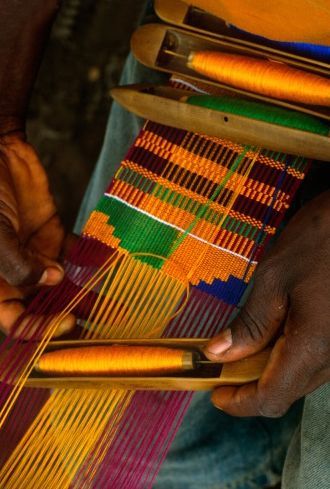We Were Never in Leaves: An African Loom & the Civilisation We Wove

The Fabric of a Forgotten Memory
There’s a familiar image quietly passed down—an image often implied, rarely said outright: that before colonial contact, Africans roamed bare or clothed in crude leaves and bark. Before Europe, there was no fabric of society—literally. That our civilisation began with ships docking on our shores.
This perception—shared by outsiders and, tragically, internalised by many Africans—is not only false, but deeply unfair. Long before colonial masters arrived with wool and linen, African communities were already threading civilization into fabric. They were weaving cloth not only for warmth or modesty, but for status, ceremony, identity, and commerce.
And the loom stood at the centre of it all. At the heart of Africa's civilization.
The Loom Was Not Borrowed
In Yoruba towns, in Igbo villages, across Hausa markets and in the valleys of the Ashanti , looms clattered and clicked long before industrial machines did. These were not borrowed technologies. They were indigenous systems—refined over generations, passed through maternal lineages and guilds.
The Yoruba, for example, are known for Aso-Oke—a handwoven cloth reserved for special occasions, whose artistry lies in its laborious detail and colour symbolism. The Igbo people had the Akwete cloth, woven on vertical looms mostly by women, and prized for its delicate craftsmanship. Across the Gold Coast, Kente cloth was not just fashion, but language. Each pattern told a story, each colour conveyed a message.
These looms—wooden, simple, enduring—were evidence of a thriving textile culture. They defy the narrative that portrays African innovation as something always inherited, never invented.
A Cloth Economy That Mattered
But this wasn’t just art. It was the economy. In many West African societies, woven cloth functioned as currency. Strips of handwoven textile were traded for goods and services, used to pay fines, or presented in marriage rites and funerals. The cloth wasn’t just cultural—it was capital.
In trans-Saharan trade routes, fabric was one of the goods exchanged for salt, gold, and even horses. Traders from the Sahel to the savannah recognised the value of African cloth. And as early European explorers made their way inland, many were surprised to find societies already sophisticated in textile production—some even exporting surplus.
This was no society of loincloth and bark. This was a continent draped in structure.
Colonial Censorship in Thread and Thought
Yet, something shifted. With colonisation came the slow erasure of these histories. European goods, including textiles, flooded the markets—cheaper, industrial, and aggressively promoted. Traditional looms became symbolic of the old and “uncivilised.” Colonial governments preferred printed uniforms to cultural cloth, Western tailoring to indigenous draping.
It wasn’t just fabric that was displaced. It was an identity. The loom fell silent in many towns—not because it lost its utility, but because it lost its dignity.
Even worse, colonial education began rewriting what history couldn’t erase. Schoolbooks rarely mentioned local weaving traditions. Museums stored them as relics, not evidence of industry. And generations of Africans were raised believing that civilization was something that came on a ship.
The Subtle Power of Weaving
SOURCE: pexels
But to weave is not merely to manufacture cloth. It is to organise rhythm, repetition, discipline, and design. It is mathematics on thread. It is history told in colour. The people who wove were not primitive. They were planners. They were artists. They were builders of a social order—stitched together by their own hands.
The loom, in African culture, wasn’t a factory. It was a philosophy.
Think of the woman in Akwete, folding warp over weft, knowing which thread goes where without measuring tape or written pattern. Or the young boy in Ilorin helping his father tie-dye cotton before weaving it into what would later be worn by chiefs. These weren’t chance behaviours. They were learned systems—developed not in classrooms, but through generations of encoded knowledge.
A Mirror to the Present
Today, African fashion is global. Kente appears on red carpets.Aso-Oke is reimagined on runways. But often, the roots of these fabrics are overlooked. We know how to wear them, but not how they were made. We appreciate their aesthetic, but forget their legacy.
As African cities modernise, we risk losing not just the loom, but the memory of what it meant. The stories tied into those patterns. The status they carried. The meaning behind the warp and weft. And more dangerously, we risk believing the lie that none of it existed until someone told us it could.
Yet, there’s still hope.
Communities in Nigeria, Ghana, and Senegal are reviving traditional weaving. Women in rural areas are training young girls to carry on what was nearly lost. Cultural festivals now include loom demonstrations. Universities are beginning to take oral histories seriously again.
This is not nostalgia. It is a reclamation.
.jpeg)
SOURCE: pexels
Not Primitive, But Profound
To say Africans once wore leaves is not just historically inaccurate—it is deeply violent. It strips away centuries of innovation, erases the economics of cloth, and undermines the complexity of identity. Our ancestors were not naked until touched by Europe. They were clothed in meaning.
The loom was never a symbol of poverty. It was a marker of pride. It defined the social calendar—what to wear to birth, to burial, to festival. It was how love was expressed in a bride’s dowry, how diplomacy was marked in royal gifts, how boundaries were drawn between tribes through motif and palette.
So when we talk about African civilisation, we must not just speak of pyramids or bronze statues. We must speak of thread. Of the loom. Of those who wove identity into cloth long before it became fashionable.
A Closing Stitch
If colonisation stole anything, it wasn’t just land or labour. It was the confidence to see our systems as valid. The African loom proves we were never uncivilised. We were never naked. We were never waiting to be dressed in borrowed ideas.
We spun meaning from cotton. Wove logic into cloth. And stitched civilization into every fold.
You may also like...
Super Eagles' Shocking Defeat: Egypt Sinks Nigeria 2-1 in AFCON 2025 Warm-Up

Nigeria's Super Eagles suffered a 2-1 defeat to Egypt in their only preparatory friendly for the 2025 Africa Cup of Nati...
Knicks Reign Supreme! New York Defeats Spurs to Claim Coveted 2025 NBA Cup

The New York Knicks secured the 2025 Emirates NBA Cup title with a 124-113 comeback victory over the San Antonio Spurs i...
Warner Bros. Discovery's Acquisition Saga: Paramount Deal Hits Rocky Shores Amid Rival Bids!

Hollywood's intense studio battle for Warner Bros. Discovery concluded as the WBD board formally rejected Paramount Skyd...
Music World Mourns: Beloved DJ Warras Brutally Murdered in Johannesburg

DJ Warras, also known as Warrick Stock, was fatally shot in Johannesburg's CBD, adding to a concerning string of murders...
Palm Royale Showrunner Dishes on 'Much Darker' Season 2 Death

"Palm Royale" Season 2, Episode 6, introduces a shocking twin twist, with Kristen Wiig playing both Maxine and her long-...
World Cup Fiasco: DR Congo Faces Eligibility Probe, Sparks 'Back Door' Accusations from Nigeria

The NFF has petitioned FIFA over DR Congo's alleged use of ineligible players in the 2026 World Cup playoffs, potentiall...
Trump's Travel Ban Fallout: African Nations Hit Hard by US Restrictions

The Trump administration has significantly expanded its travel restrictions, imposing new partial bans on countries like...
Shocking Oversight: Super-Fit Runner Dies After Heart Attack Symptoms Dismissed as Heartburn

The family of Kristian Hudson, a 'super-fit' 42-year-old marathon runner, is seeking accountability from NHS staff after...
.png&w=1920&q=75)






